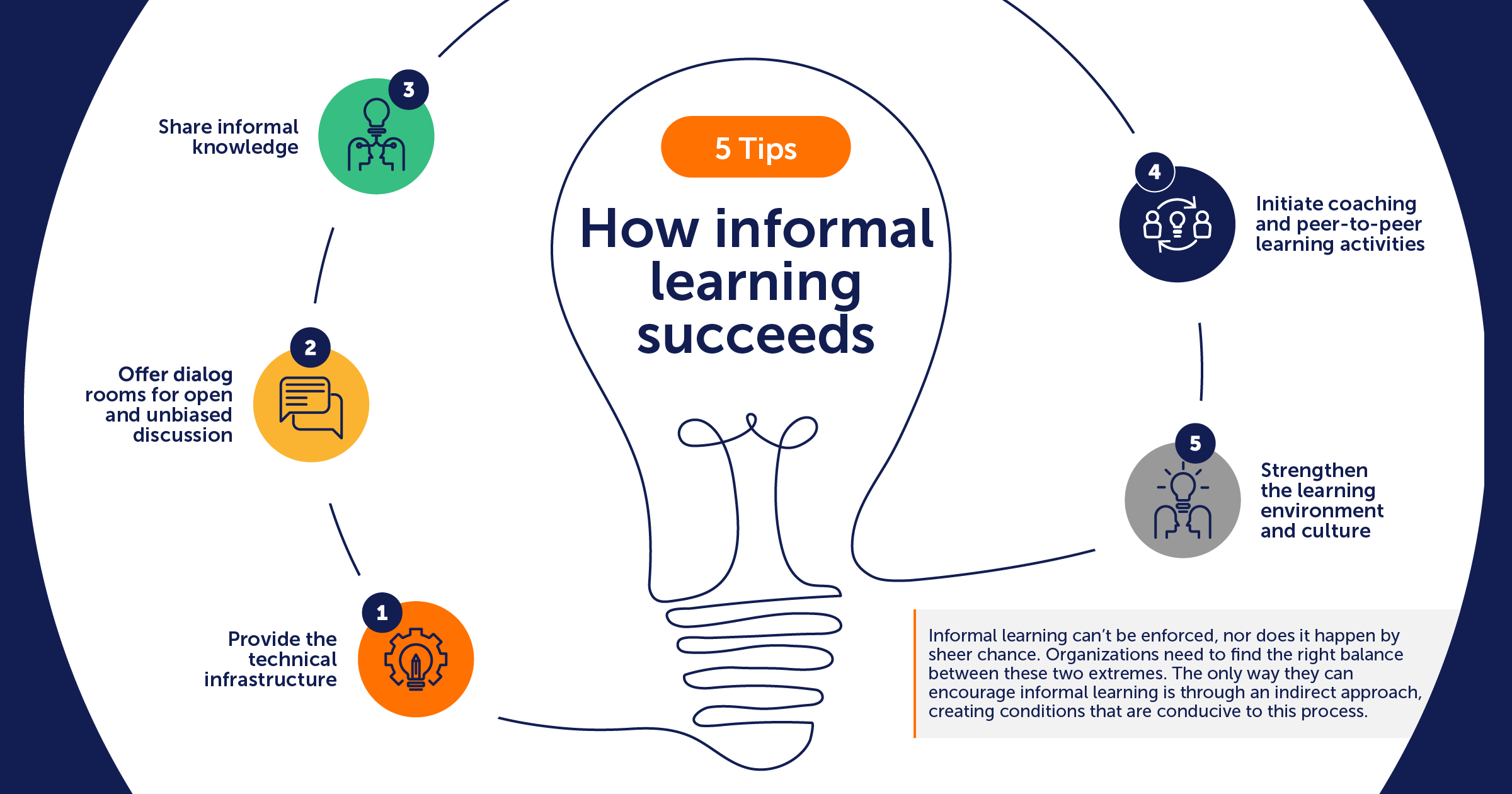Informal learning – five tips for successful skills development
A large part of learning in organizations takes place in a spontaneous, unstructured manner, such as when employees take on challenging tasks, try something new (learning by experience) or interact with one another. This is exactly what makes informal learning processes absolutely vital for organizations that want to remain adaptable. Instead of learning that takes place separately and outside our working context, we always look for new knowledge when we actually need it. We learn in ways that suit our situation and meet our needs – by conducting online research when we have a specific question, consulting Wikipedia or asking the colleague sitting next to us for advice, for example.
By and large, this fits with the “70-20-10 model” developed by Lombardo and Eichinger. According to this model, only around ten percent of learning takes place via formal methods such as eLearning or training sessions. We develop most of our expertise through our own workplace learning and experiences (in other words, learning by doing), actively solving problems or working on a particular topic and discussing it with others. Even if the 70-20-10 model is rather simplistic and controversial for a range of good reasons, there is a general consensus that on-the-job, workplace learning that takes place informally is the most common form of professional training.
Definition of informal and formal learning
Before informal learning can be promoted in an organization to the best possible effect, it is important to understand exactly what it means and how this form of education works. In a definition dating from 2001, the European Commission distinguishes between “formal”, “non-formal” and “informal” learning.
Both non-formal and formal learning take place via structured training formats. However, while formal learning leads to a professional or educational qualification or certification, the same is not true of non-formal learning. “Informal learning” applies to everything else – in other words, all learning that takes place outside the context of formal formats of professional education and training.
The following features are characteristic of informal learning in the workplace:
- The process is one of self-directed learning, but it does not involve implicit learning, which commonly occurs in an everyday or leisure context.
- Learning takes place spontaneously and reactively, in relation to challenges that arise in the work process.
- The learning goal is the rapid, situation-dependent and personalized development of knowledge and skills to solve a specific problem.
- The acquired knowledge and skills are applied directly in the workplace. The direct, immediate context means information is often absorbed more effectively than, for example, content taught as part of a professional training course.
In contrast to formal formats, informal learning can take place in almost any situation, including social situations – in digital forums, in the office, in the coffee room, in the corridor, at a production machine, on the warehouse ramp, by watching publicly available videos or by consulting Wikipedia. With this form of education and learning, opportunities generally arise spontaneously, such as during discussions about work, difficult project situations or new software. It might start by one person asking “Could you give me a hand?” or by somebody suggesting “I’ll show you how I do it”.
Why is informal learning important?
Informal education lets employees learn what they actually need – perhaps because the organization doesn’t (yet) offer any formal training on the relevant topic. After all, L&D, staff development teams or learning academies cannot supply the requisite, very diverse range of training fast enough to keep up to date with the rapidly changing needs of today’s working world.
The pandemic also demonstrated this very clearly. Many employees switched to working from home from one day to the next and started using digitally supported forms of communication and collaboration on an ad hoc basis to organize their day-to-day work. Even though a considerable proportion of the workforce had no previous experience of these ways of working, and very little formal training was available, the transition worked surprisingly well in most organizations. Those affected obviously worked a great deal out for themselves – and all within a very short space of time.
Advantages of informal learning
Empirical studies refer to the following benefits of this form of learning:
- Flexible and close to learners’ needs. Formal courses or learning modules and resources often need to be planned or developed well in advance. However, watching a video on a platform or asking a colleague can happen spontaneously.
- Easier to transfer the content learned to the practical application, since the learning experience takes place on demand. With formal learning, in contrast, material is learned in advance, regardless of whether the knowledge is needed immediately or not.
- Boosts innovative ability. When employees interact with other learners or take opportunities to learn away from the organization, they bring knowledge and experience back to their own workplace that they can then use to initiate improvements or suggest new solutions.
- Generally cost-effective, since no major outlay is required for planning, no course materials need to be supplied and no (external) training staff need to be involved.
However, informal learning activities cannot be equally relevant and effective across all areas of professional training and development. Particularly when it comes to jobs that are regulated by strict standards or where even the tiniest deviation from the standard process could have far-reaching consequences, such as in the aviation industry or healthcare sector, formal learning within the context of professional education and training is vital, and evidence of the relevant skills and know-how is mandatory.
Informal learning doesn’t just happen by itself
Given the various insights and advantages mentioned, many organizations are now turning their attention to informal learning. However, they are not always successful, especially if, for example, 70-20-10 has led them to believe that employees can organize their own informal learning entirely by themselves or that this form of learning just “happens” automatically. Practice has shown that simply handing responsibility over to employees is not a satisfactory approach. The hectic pace of a normal working day rarely leaves any room for informal learning. In the worst-case scenario, this can result in employees being forced to do their work-related learning during the evening or in what should be their free time.
If informal learning is to be successful, suitable structures are therefore called for that will create learning opportunities. Consequently, a first step may involve considering the general conditions in the organization and asking the following question: In terms of our employees’ learning, what can we do to hinder them as little as possible?
Taking obstacles out of learners’ ways
There is a common misconception that informal, learner-driven education is essentially synonymous with a social pastime or inefficiency. People think along the lines of: “They’re watching yet another video or chatting with colleagues instead of getting on with their work”. A change of mindset is needed here. Informal learning can only ever succeed when the necessary trust is put in employees and they are given opportunities to seek out the support they need to complete their tasks.
Certain remuneration or bonus systems can also be an obstacle if working through a list of tasks ends up competing with the learning process. Specifying pre-determined periods of time for informal skills development, along the lines of “Every member of staff should devote two hours each week to self-study” – even when done with the best of intentions – doesn’t help either, since this doesn’t resolve the conflict between incentivized work output and prescribed “learning days” or an imposed “learning time tally”. As a result, those affected see the prescribed learning as a nuisance or an interruption to their work. In the worst-case scenario, employees merely pretend to be learning, while quietly getting on with the tasks that arise.

Five tips – creating the right conditions for learners
What, then, is the solution if informal learning can be neither enforced nor left to chance? How can organizations strike the right balance?
This can only be achieved indirectly by creating the conditions that encourage learning:
- Provide the technical infrastructure. Whereas, in the past, access to informal learning resources was often completely blocked, organizations now often steer a middle course. For example, they might make a learning experience platform (LXP) available with curated content such as podcasts, TED Talk videos or eBooks, and leave staff to choose freely from these resources.
- Offer dialog rooms for the open and unbiased exchange of views, knowledge and experience. This might be a meeting room within the production workshop, for example, where employees from various sections are given the time and space to reflect on their own work. These spaces can also be virtual and serve as a platform for trying out new things, seeking or giving feedback, pursuing new ways of thinking, or expanding the repertoire of solutions.
- Share informal knowledge. When skills that have been acquired informally are shared, their value becomes visible and accessible to other employees. User-generated blogs or internal wikis, for example, are good ways of sharing knowledge and experience with other learners. Regular retrospectives about the nature of joint work, such as in the form of rounds of feedback, are another way of supporting the informal exchange of experience.
- Initiate coaching and peer-to-peer learning activities. Employees who are particularly skilled in a certain area can be encouraged to act as learning experts and support their co-workers. In the case of peer-to-peer learning, staff discuss difficult or controversial topics with the aim of finding solutions together.
- Strengthen the learning environment and culture. People learn from mistakes. It is therefore vital that mistakes in education and work processes can be identified, jointly reflected upon and used to improve these processes. However, this can only happen if failure is dealt with constructively and there are structures in place that promote a psychological sense of security in the workplace. It is then that the working culture becomes a genuine learning culture.
Informal learning is not a “miracle cure”
Informal learning in the workplace can only thrive in the long term if the value attached to this form of training and the understanding of how it works continue to grow and develop. It is important to remember that learning in the organization is a fragile ecosystem that can easily be upset by the wrong type of intervention.
In spite of the benefits of informal learning, organizations should not regard this format as a “miracle cure”. Instead, its potential should be recognized and developed by creating suitable structures and interweaving informal learning with formal options. After all, formal education and other learning formats will continue to be important parts of an organization’s training, especially in terms of compliance requirements and the sectors subject to statutory regulation, as already mentioned.
 Johannes Starke
Johannes Starke




